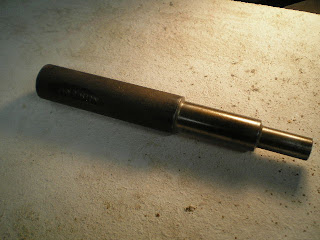
Any device that maintains the concentric alignment between the clutch disk and the pilot bearing can be made to serve.
The standard VW tool was made of hardwood. If you have a wood lathe, making such a tool is a snap. Little end matches the pilot bearing, shank matches the hole in the clutch disk (you can ignore the splines, focus on the hole) and anything left over serves as a handle.
Put your mind to it, you'll see that you don't even need the lathe; anything that can hold a hardwood dowel while spinning the thing can be made to work, and a rasp does just fine as a cutter.
(Ed.Note: I made the alignment tool in the photo above for my '73 Datsun [which I still own].)

 Have you got a set of deep sockets? See if you can find one that is a reasonable fit in the pilot bearing. Now see how well the big end of the socket fits the center of the clutch disk. I have a set of metric sized, 3/8" drive deep-sockets made by S-K. The 10mm socket makes a perfect alignment tool for the VW clutch disk.
Have you got a set of deep sockets? See if you can find one that is a reasonable fit in the pilot bearing. Now see how well the big end of the socket fits the center of the clutch disk. I have a set of metric sized, 3/8" drive deep-sockets made by S-K. The 10mm socket makes a perfect alignment tool for the VW clutch disk.Lots of folks sell cheap plastic alignment tools. Before using anything made of plastic for this purpose you should check the alignment of the tool itself. In a lot of cases the little end is at a distinct angle to the clutch-part, guaranteeing you'll never get the engine to slide on to the main-shaft.
You'll also see a lot of stuff about how an old main-shaft makes the perfect alignment tool. Which it does. But only if you keep that sucker absolutely, positively horizontal when torquing up the pressure plate. That's because an old mainshaft is also a worn-out mainshaft, especially with regard to its fit in pilot bearing and the splines for the clutch disk. Old mainshaft generally means a sloppy fit, which leaves a lot of the alignment up to you.
This is one of those problems that can have you bleeding from the eyes because all of the Instant Experts tell you what a great idea it is to use an old main-shaft... but none of them take the trouble to mention what happens if the shaft is allowed to droop, or when it's worn so badly that it fails to keep the clutch disk concentric to the pilot bearing.
--------------------------------------
Funny/Sad Story: Couple of kids, first bug; taking advantage of their first engine removal (bad clutch) to add tons of those kewl improvements you can just bolt on, makes a bug go a thousand miles an hour, etc.
Couldn't get the engine back in. Spent something like three days really trashing that poor bug before the mother of one of the kids got in touch with my wife to see if I could drop by, maybe give them a hand.
When I showed up, the clutch disk was visibly misaligned. When I pointed out the misalignment they were defensive, didn't need any help, etc. They called said the need for an alignment tool was 'bullshit'. According to them, the clutch disk would align automatically as the engine was installed.
So I left them to it. You can lead a horse to water but from that point on, the rest of the job is up to the horse.
-Bob Hoover
(Ed.Note: I posted the above several years ago, leaving out a lot of details such as the fact the family were renters and that major car repairs were a violation of their rental agreement. I eventually got the kid back on the road but only after the family had been threatened with eviction. But once the engine was installed it ran like shit, thanks to all those improvements the kid had installed at the instigation of his equally ignorant buddy. As with most of these tales, it didn't have a happy ending and another bug ended up in the crusher.)